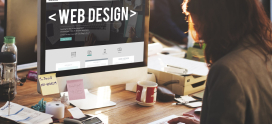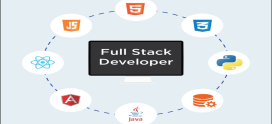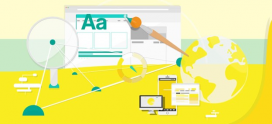6 Ways SEO & Web Design Go Together
By: Marie Barnes
Date: 04 Aug 2020
Often, SEO specialists are only remembered at the stage of preparing a project for launch after redesign or development. A specialist comes to the "ready" site, forms the necessary corrections. But, suddenly, goes against the concept that the designers used to adhere to.
Disagreements between the two directions (SEO and design) lead to additional costs for extraordinary changes in the site. Even a fully consistent site, with all the latest design trends implemented, however, without SEO promotion will not receive organic traffic. At the same time, even the most perfect (in terms of search engine requirements) platform, which lacks good design solutions, will eventually cease to perform its function. Thus, SEO and Web design turn out to be equally important on the development stage.
Why should a site have the right design?
First of all, good design - is not merely qualitatively elaborated shadows and pleasant colors. Good design is primarily useful: if the interface is user-friendly, a visitor will quickly find the information he or she needs. The quality of the images is especially important if your site is an online store or offers visual services. In such case, the images should be of the highest quality possible. Photos must be taken by a professional photographer, retouching can be done on your own, or ordered through online services such as this one.
In 2018, experts from McKinsey reported on the assessment of the economic effect of the design, having studied approaches in 300 companies around the world. Would be wrong to say that there exists a direct dependence on sales growth, based exclusively on visual components. Nevertheless, it is crucial for any project success.
Another important thing to mention: a properly implemented design works regardless of the specifics, sphere, and type of service (the study examined companies from different fields, such as medicine, banking services, science, etc.).
But the launching of a website with user-friendly and pleasant to the eye architecture is not a guarantee of profit growth: there is more to it. A field of visual representation has a huge number of sources that allow you to get feedback from the consumer and determine the points of growth. The role of the optimizer in the development of the site`s visuals massively depends on marketing, as well as SEO. The effect of a website with high-quality visual components and a proper focus on SEO-promotion will be stronger when both of these tools are used in an integrated way, complementing each other.
The search engine promotion and visual components of the project are closely connected and interdependent since they both play a crucial role in determining the behavioral factors of the site. Web design, in turn, is focused on making the site convenient for the user.
However, site promotion in search engines does not begin with an analysis of how the user behaves on it, in order to determine whether the project meets the requirements of search engines. Link Building is also necessary during site promotion. Most site owners don't know how to buy quality backlinks. After all, the first user must be brought to the site from Google.
Structure
How is the information about the company, services/goods placed on the pages of the site? Is it convenient to navigate through the sections and to determine where exactly the needed information is?
While developing the structure of the site it is necessary to determine the level of nested pages in accordance with their importance to each other. Separately, you should pay attention to how the navigation is technically implemented.
Ideally, the URL addresses of pages should be fully consistent with the hierarchy of the navigation chain. When all internal pages of the site have the same level - it is not good for the site. Moreover, depending on the level of the page, its visuals should have some changes.
Navigation
The basic navigation element is the menu, it visually reflects the structure of the site and helps the user to move quickly between sections. Therefore, it should be accessible from all pages and contain links to all the main sections.
In addition to the menu, navigation can also include such elements as "breadcrumbs", filters and sorting of goods, links to similar materials or goods, etc. Everything that helps the user to get the necessary information quickly is very important. All basic links should be readable for humans and indexable by search engines.
Content
Content is the basis of search engine promotion. Determining the optimal amount and options for content on the landing pages is not an easy process. Moreover, it should be perfectly placed into the visual part of the site. To bring the pages of the site to full operational readiness requires the analysis. So let's denote only the most necessary elements to pay attention to:
- Information about goods and services. Everything that concerns a company's activity: cost, specifications, examples of work, etc.
- This is a visual representation of the activities. First of all, we are talking about images, however, the video format is becoming more and more relevant.
- Yes, they are not always needed, but very often it is an objectively necessary element. A competent presentation can interest visitors.
Headings
Let's begin with the notion that headings are absolutely indispensable. There are a number of rules regarding their proper usage:
- On one page - one main header H1. It should have the main phrase or word that describes the essence of the page.
- It is necessary to observe the hierarchy of headings. For example, H1 should never be placed below the heading H2.
- Cross-cutting elements of the site should be made of CSS styles, and not using any H headings.
In terms of page layout, the same rules are provided in the laws of typography, but experience shows that observing all these requirements at the stage of technical implementation is not always obtainable.
Architecture of pages
We are talking about the compositional arrangement of the main elements of each page. Depending on the tasks, it is necessary to determine the priority of each element and set the accents.
For example, the first thing that should catch the eye of the user of the online store - is a listing of goods with a photo, prices, and a brief list of basic features. At the same time, the person who has got on the page of an information resource should understand at once, whether he or she will find the answer to the question or not.
Probably, in the future, with the appearance of data on the effectiveness of the page, its architecture will be corrected to improve the result. But the basic elements must be defined in advance and have more "weight" among other content.
Page loading speed
This technical indicator is increasingly important for search engines and affects the position of the site directly. It is already quite possible to call an independent ranking factor. Evaluating the speed of the site is possible using the service PageSpeed Insights (Google).
The main principle: you need to implement the visual component and functional elements of the site so that they have as little load on it as possible. It is important for the user to have a positive first impression of the site, and a long load can significantly undermine it. Optimal page load time - no more than two seconds.
Conclusion
As we can see, SEO and Web design go together during the stage of a site’s development. A project with a competent design is an effective marketing tool. Its development should be based on user needs and requirements of the main traffic source - search engines.
Website development without one of these two specialists will entertain a potentially large cost. Cooperation between designers and SEO-specialists should be complementary, and integral to each stage of the development, starting with the very beginning of the site creation.



